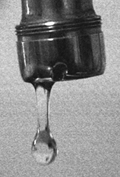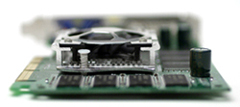Glossary
These are just some of the terms that we thought were particularly important to know before reading our articles. We will explain detailed features of individual cameras in our reviews.F-Stop: An f-stop number refers to the size of the aperture opening. Think of the aperture as working the same as our pupils. If there is too much light, our pupil must shrink down to limit the amount of light coming into our eyes. The opposite occurs if there is not enough light - our pupil will dilate to let in more light. This is the same type of process that a camera must employ in order to attain a proper exposure when taking a picture. Typical examples of f-stop numbers are between f/1.0 - f/22. If the number is higher, the opening will be smaller and will let in less light. If the number is smaller, the opening will be larger and will let in more light.
| Shutter speed: The shutter speed refers to how long a picture is exposed. In lower lighting conditions, you must use a slower shutter speed in order to allow enough light to give a good exposure. On the other hand, if you are outside on a bright day, you would have to use a much faster shutter speed for the same type of exposure. Typical shutter speeds range from slow (30 seconds) to really fast (1/4000th of a second). The speed of the shutter will greatly affect the way movement is captured on a picture. A fast shutter speed (anything above around 1/500th) will freeze fast action such as water dripping (top right), while slow shutter speeds can be used for numerous creative effects (bottom right). Slow exposures are commonly used when taking pictures of waterfalls to give them a silky look, for example. Shutter speeds and f-stops have an inverse relationship. In other words, changing the shutter speed to the next fastest setting, while changing the f-stop to the next lowest number, will retain the same exposure effect. |
|
Depth-of-field: The easiest way to explain depth-of-field is to use examples. A small depth-of-field produces a picture that has a specific focal plane in focus (below left). A large depth-of-field, on the other hand, produces a picture where the area in front of the focal point, the focal point, and the area past the focal point are all in focus (bottom right). Depth-of-field is dependent on the aperture setting of the camera. The larger the aperture opening (smaller f-stop number), the smaller depth-of-field that you will achieve; while the smaller the aperture opening (larger f-stop number), the greater the depth-of-field. A small depth-of-field is often desirable when you want to direct the viewer's eyes to a specific part of the picture. This effect is especially used in portraits where the background has a soft blurred look and the subject is focused. Famous photographers, like Ansel Adams, have popularized the use of extremely large depth-of-field, by using high f-stops, to take clear pictures where everything is in focus.
|
|
|
CCD: A CCD sensor is one of the two main types of image sensors in digital cameras. CCD stands for Charge Coupled Device. Digital cameras with CCD sensors are the most common type used, but they tend to be more expensive to manufacture. They also consume more battery power than CMOS sensor-based cameras.
CMOS: CMOS (complementary metal oxide semiconductor) is the other main type of image sensor. It is generally used in lower-end digital cameras because they are cheaper to manufacture. However, they are now being used for some professional digital cameras. They tend to be more efficient with battery power.
ISO: ISO is also referred to as the speed setting of a camera. Digital cameras offer a range of settings, typically from ISO 50-800. The higher the speed setting, the more sensitive the camera will be to light. Photographers select different speed settings depending on the lighting situation. This gives them more options when it comes to setting f-stop and shutter speeds. ISO is also used in film cameras to indicate the light sensitivity of a specific roll of film. Lower ISO settings tend to result in less grainy pictures while high ISO settings will generally produce a grainy effect.
Metering: Nearly all digital cameras have built-in light meters. This means that when you point the camera at the subject that you are trying to capture, your camera will automatically determine the f-stop and shutter speed that you should use. Most cameras also have a fully automatic mode where it will adjust these settings for you, allowing you to simply point and shoot.
Hot-shoe: This term refers to a slot found on the top of some cameras that provides the option of attaching an independent flash.
Aperture Priority: Aperture priority is a setting on most digital cameras that allows you to specify what aperture you want to use. The camera will automatically set the shutter speed accordingly to obtain a good exposure.
Shutter Priority: Shutter priority is just like aperture priority, except that you set the desired shutter speed and the camera will pick the correct aperture needed to provide a proper exposure.














7 Comments
View All Comments
GOSHARKS - Thursday, July 8, 2004 - link
ianmills - heavily biased? i have yet to see any sort of bias on the largest and most popular digican review sites (dpreview, dcresource, imaging resource, steves digicams, megapixel.net, etc)ianmills - Wednesday, July 7, 2004 - link
Most sites that review digital cameras are HEAVILY BIASED. Let's hope Anandtech can be more objective than the other sites in their reviews.I just skimmed the article quickly (so you may have already included this), but I WOULD LIKE TO SEE a test of how long you need to wait between each picture that is taken. I have a a Canon A300 and it takes almost 10s between each picture when the flash is used ><
Unfortunately none of the camera review sites mentioned this flaw (but otherwise the camera is good ^^)
PrinceGaz - Monday, July 5, 2004 - link
I've got to agree with those who wonder what AT can add to the already well catered for online digial-photography sector. Sites like imaging-resource.com and others mentioned in earlier comments have many in-depth reviews every month so that they cover pretty much every digital camera available. They specialise in nothing but digital photography and everyone involved with the site is an expert in it, who knows about every product available together with its strengths and weaknesses and together can give an informed opinion.AT is a site which covers computers and the people who do the reviews here are all experts on computers in much the same way. Thats what makes this site one of the top PC hardware sites on the net.
Although digital photography using computer equipment may make it seem like the two are similar and can be covered together, doing so is a bit like a site which specialises in cars deciding to look at a few caravans as well. Yes you need a car to pull a caravan, but the two are used for quite different purposes and need to be considered entirely seperately, except for a mention of what power of car is needed to tow a particular caravan.
Unless AT is prepared to create what will need to be at least as equally large a site as the existing AT covering nothing but cameras, something like anandtech-cameras.com for instance, the camera reviews will be of very little value. I'm sorry to sound pessimistic about this new part of AT, but its just far too large a field to hope to cover without more than doubling in size. Theres a real danger of being seen as a jack of all trades...
shuttleboi - Monday, July 5, 2004 - link
I doubt a gadget website like Anandtech has anything of value to add over the content found in DPReview.com and others, but just in case the author(s) are working in earnest: One test that needs to be added is a luminance test to show a digicam's noise sensitivity to higher ISO. Such a test will reveal how digital SLRs like the Canon 300d/10d and Nikon d70/d100 stand out from point-and-shoot cameras and even mid-range cameras like the Sony 828. The light sensors in digital SLRs are much larger than those found in smaller digicams, thereby allowing users to dial up higher ISO without nearly as much noise. For example, by going from ISO 100 to 800, you've gained 3 stops of overexposure, so you can reduce your shutter speed by 3 stops, which is invaluable when you're in low-light situations. Digital SLRs have little noise at ISO 800, whereas cameras with smaller sensors (even the Sony 828 or Canon PowerShot Pro1) produce fairly noisy images even at ISO 200. Even at ISO 1600, my Canon 300d produces acceptable results not much worse than the grainy slide film in my old film SLR.jliechty - Monday, July 5, 2004 - link
Hmm, it looks like the new system is chopping off extra paragraphs in commments. There should be a second paragraph to this comment.jliechty - Monday, July 5, 2004 - link
#1 - I don't know for sure, but it will be interesting to see what they come up with.LX - Monday, July 5, 2004 - link
Between full-time digicam review sites like dpreview.com, imaging-resource.com, dcresource.com, megapixel.net and steves-digicams.com what can you add to the mix?